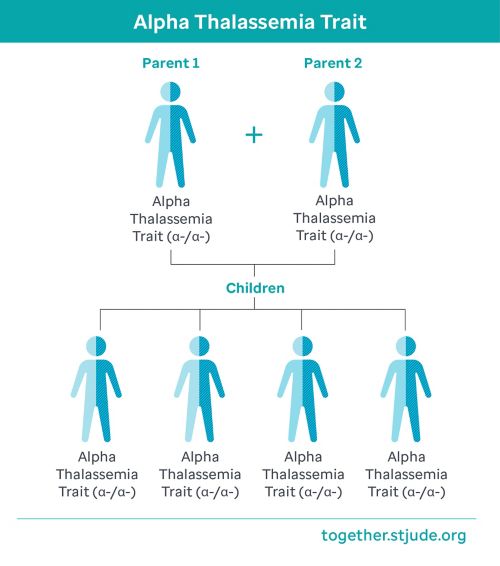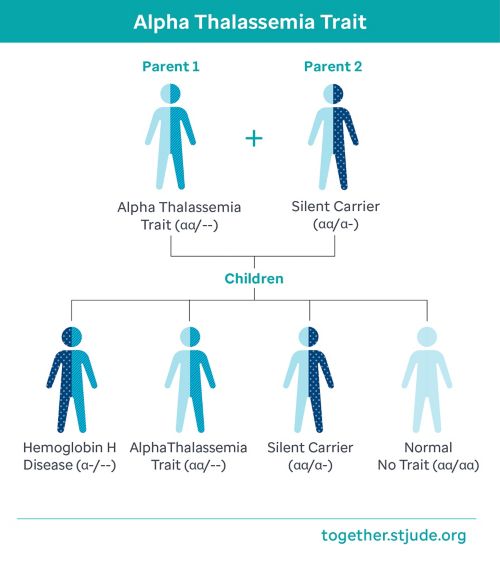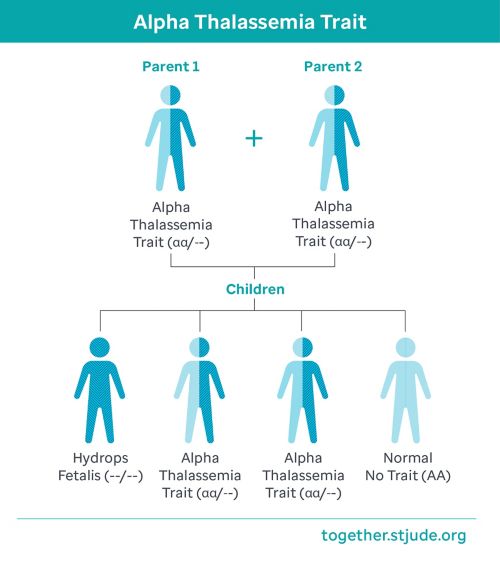What is alpha thalassemia trait?
Alpha thalassemia trait is a change (mutation) in a gene that helps make hemoglobin in red blood cells. People with the trait have missing or damaged genes. The genes for alpha thalassemia trait are inherited, or passed from parents to children, like hair color or eye color.
A trait is different from a disease
Alpha thalassemia trait is not a disease. Most people with alpha thalassemia trait have no signs or symptoms of illness. The trait can sometimes cause mild anemia. But it normally does not cause serious problems.
What is alpha thalassemia?
Alpha thalassemia is an inherited blood disorder that causes you to make fewer red blood cells and less hemoglobin. Hemoglobin is a protein that carries oxygen from the lungs to all parts of your body. There are two parts of hemoglobin: alpha globin and beta globin.
Certain genes control how the body makes hemoglobin. When these genes are changed or missing, thalassemia occurs. The specific hemoglobin protein affected in alpha thalassemia is the alpha globin.
People with alpha thalassemia have fewer alpha globin genes than normal. Normally, people have 4 genes for alpha globin. People with alpha thalassemia mutations can be missing 1, 2, 3, or 4 alpha globin genes.
Parents who have alpha thalassemia trait can pass the genes on to their children. Their children might be at risk for more severe alpha thalassemia including hemoglobin H disease or hydrops fetalis.
Risk factors for alpha thalassemia trait
Alpha thalassemia is common in people whose ancestors came from Africa, Southern China, Southeast Asia, the Middle East, and the Mediterranean region. It is possible for a person of any nationality to have alpha thalassemia trait.
Tests for alpha thalassemia
A blood test can let you know if you have alpha thalassemia trait. It may be done as part of genetic screening. Your doctor may also recommend the test if someone in your family has alpha thalassemia.
There are 2 types of alpha thalassemia trait: trans and cis.
- Trans type (α-/α-): People with this type of alpha thalassemia trait have 1 alpha globin gene missing on each chromosome. If both parents have the trans form of alpha thalassemia trait, all of their children will have alpha thalassemia trait. The trans form is more common in people of African descent.
- Cis type (αα/--): People with the cis type of alpha thalassemia trait have 2 missing alpha globin genes on the same chromosome. The cis form is more common in people of Asian descent.
Silent carrier of alpha thalassemia
People with 1 missing or damaged alpha globin gene (αα/α-) are called silent carriers of alpha thalassemia. This means they can pass on the condition of having 1 gene missing. The missing gene does not affect their health or the way they feel. This is also called alpha thalassemia minima.
- A silent carrier does not have any symptoms.
- If you are a silent carrier, you do not have hemoglobin H disease and cannot develop it later in life.
Newborn screening test: Bart’s hemoglobin
A finding of Bart’s hemoglobin on the newborn screening test means that there are alpha globin gene mutations. The baby might have alpha thalassemia trait, alpha thalassemia, or hydrops fetalis.
- If a small amount of Bart’s hemoglobin is present at birth, it will usually disappear shortly after birth. This means your child has 1 or 2 missing genes and has alpha thalassemia trait or is a silent carrier. Normally, a second newborn screening test will not detect this condition.
- If a large amount of Bart’s hemoglobin and hemoglobin H genes are present at birth, it usually means the baby has hemoglobin H disease (a 3 gene deletion).
- Hydrops fetalis is a condition that results from a 4 gene deletion. Usually, a baby will not survive unless it has a blood transfusion while in the womb and continues blood transfusions after birth until a permanent treatment, such as bone marrow transplant, is offered.
If your child’s newborn screening test showed Bart’s hemoglobin, talk to your doctor about next steps and follow up care. Alpha thalassemia can cause low red blood cells (anemia). This is different from not having enough iron in the blood.
Your child’s treatment will depend on the type of alpha thalassemia. Early medical care for alpha thalassemia is important to prevent and manage health problems.
Alpha thalassemia should not be treated with iron because it will not help. Alpha thalassemia can be treated with iron only if the person has low iron levels in addition to alpha thalassemia. Your doctor will tell you if this happens.



